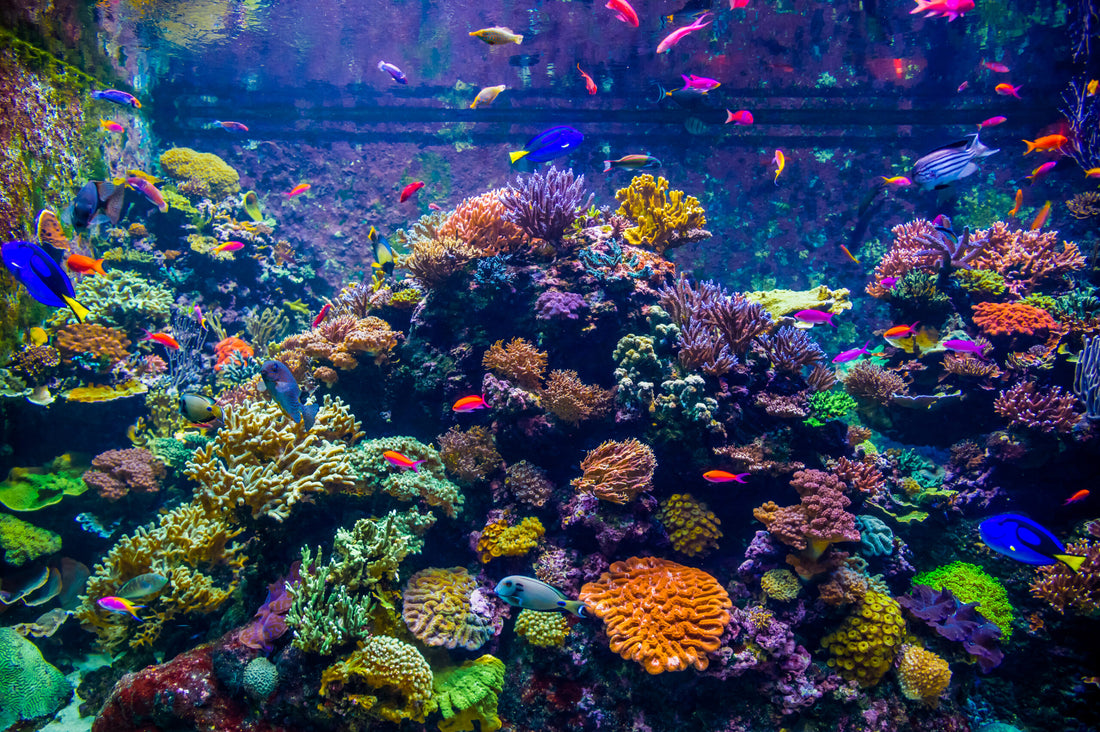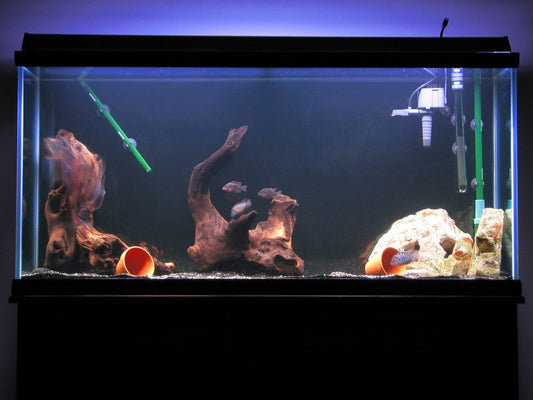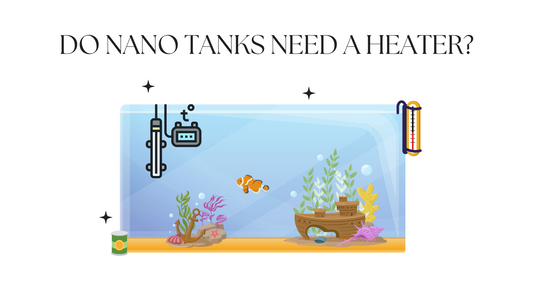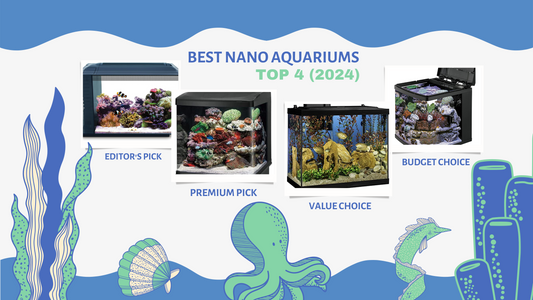Our New Refugium Setup Guide (2024)

Everything to know about Refugiums
Are you considering setting up a refugium for your saltwater tank? Don’t worry—it’s not as intimidating as it seems! Setting up a refugium can greatly improve the health of your saltwater tank and give you peace of mind knowing that your aquatic reef fish are safe and thriving with additional beneficial bacteria.
In this article we also dive into the merit behind a deep sand bed, the benefit of live rock, and how all these different tools increase the surface area of your biological filter.
What is a refugium in a Saltwater Aquarium?
A saltwater tank refugium is a separate compartment within a reef aquarium that serves several important functions. It is a highly useful addition to any reef tank, as it can help to improve water quality, provide additional habitat for marine life, and even act as a source of food for the aquarium inhabitants with the addition of copepods. It even can prevent the spread of nuisance algae!
One of the primary purposes of a refugium is to provide a place for beneficial tiny microorganisms to thrive. These microorganisms, such as macroalgae, bacteria, and other tiny creatures, play a crucial role in maintaining the overall health of the aquarium. They help to break down waste products and excess nutrients and nitrate, which can lead to improved water quality and a reduction in nuisance algae growth in your saltwater reef tanks.
In addition to providing habitat, a refugium can also act as a source of food for the reef inhabitants. Many species of algae and other microorganisms (like pods) that thrive in a refugium are considered to be highly nutritious and can serve as a valuable food source for fish, invertebrates, and other marine life. These organisms can help to improve the overall health and vitality of your reef inhabitants.
Another advantage of a refugium is that it can help to maintain a more stable environment within the aquarium by expanding the volume of saltwater in the tank. Every gallon of water adds more stability (yay for sumps!). Because a refugium is a separate compartment, it acts as a buffer against sudden changes in water chemistry or temperature. This can be particularly useful in the event of a power outage or other unexpected event that may otherwise disrupt the aquarium.
What kind of refugium setup is right for you?
Before getting started, decide which type of refugium setup is right for you: hang-on or sump-based refugium systems. The hang-on system is great if you don’t have the time or space to set up a larger sump-based system, at the expense of less water volume. This means it is not as great for macroalgae to grow. It is composed of a container that hangs off the side of your saltwater tank and usually contains a light, pump, and some live rock or macroalgae. Unfortunately, this does not leave much room for lighting due to it’s free hanging nature, limiting plant growth.
A sump-based refugium setup is typically larger than the hang-on systems and offers more space to add filtration media, protein skimmers, chemical filters, and reactors for your reef tank. This system requires you to install an additional aquarium tank below your saltwater aquarium to house the refugium. You’ll also need plumbing supplies like a return pump, tubing, valves and drill bits in order to connect the refugium to your main saltwater aquarium.
This kind of refugium tends to have more space, meaning you can add additional lighting, live rock, copepods, or pods for growth versus the average HOB system.
No matter which type of system you use for your refugium, it’s important to make sure that it is properly set up before adding any live organisms or plants, and that you have the proper space for it.
Make sure your refugium has adequate light and flow, as well as saltwater-safe filtration media like sand, rock, macroalgae or other aquatic plants. Once everything is in place, you can populate your refugium with small invertebrates like amphipods, copepods and mysis shrimp, or macroalgae such as Chaetomorpha linum or Caulerpa taxifolia.
Both are algae which experience strong growth by extracting excess nutrient in aquariums.
How to set up a refugium?
Setting up a refugium is not as intimidating as it may seem. With the right supplies and knowledge, you can easily create an effective refugium within your saltwater aquarium. The first step involves selecting the right light, pump, filtration media, and macroalgae to use in your refugium.
Once these items are in place, it’s time to choose the inhabitants for your refugium. Small invertebrates such as amphipods and copepods, as well as macroalgae like Chaetomorpha linum or Caulerpa taxifolia, are great additions to any refugium. Lastly, you may want to consider adding some small fish or other marine life in order to create a more dynamic ecosystem for your aquarium inhabitants.
With the right combination of light, flow, filtration media, and macroalgae, along with a few inhabitants, you can easily create a thriving refugium within your saltwater aquarium. With regular monitoring and maintenance of the refugium’s light, flow, and water parameters, you can be sure to have an effective way to keep your tank healthy for years to come, while reducing nitrate and detritus. Your various reef fish species will be happy to have additional locations for bacteria to grow and keep your reef tank operating at peak efficiency.
By setting up a refugium, you can benefit from improved water quality and a more diverse ecosystem. Not only will your tank’s inhabitants enjoy the nutrient-rich environment, but you’ll be able to create an aesthetically pleasing display that is sure to impress while helping your tank deal with nitrates and phosphates.
As previously mentioned, chaeto is a a great macroalgae to grow, and will provide many benefits to your main display reef tank. Adding algae sometimes sounds like an oxymoron, but chaeto is effective at removing excess nutrients, nitrates and phosphates from your tank. Chaeto is a special species of macroalgae that excels at removing nitrates, detritus, and excess nutrients.
How many hours of light do you need for Chaeto?
Chaeto requires light in order to photosynthesize and grow, but the amount of light you need will depend on your tank size and light source.
A general rule of thumb is that chaeto should receive at least 8-10 hours of light per day.
It may be beneficial to put your light timer on a sunrise/sunset setting so that the light gradually comes on and off. This will help to reduce light shock for any other inhabitants in your tank, as well as ensure that your Chaeto gets enough light throughout the day. With adequate light, nitrate levels should remain low, keeping your tank clean and healthy.

How big of a refugium do I need?
The refugium size that you need will depend on the type of refugium you are using: a HOB refugium or an in-sump refugium. Generally speaking, an in-sump refugium will require a larger tank than a HOB refugium due to its more complicated setup and plumbing requirements. As a general rule of thumb, refugiums should be at least 10-15% the size of your main tank.
So if you have a 100-gallon aquarium, you would want your refugium to be at least 10 gallons in size. However, it is important to remember that bigger refugia are not necessarily better refugia. Many refugiums are on the smaller side and still do an excellent job of filtering water, removing nitrates and phosphates, and providing a safe haven for beneficial algae and macroinvertebrates.
By setting up a refugium that is well-stocked with macroalgae, light, flow and
I’ve always been a fan of some of the smaller inhabitants in saltwater aquariums, so unsurprisingly being able to grow pods in my refugium has always been very exciting to me. Pods provide a great food source for fish, and combined with algae add another location to your biological filter strategy.

What to include in a saltwater aquarium sump?
A sump is an essential piece of equipment in any saltwater aquarium setup. It’s essentially a container that hangs off the side of your display tank and houses all the mechanical filtration media and other components such as protein skimmers, chemical filters, reactors, etc.
You’ll also need to use plumbing supplies like a return pump, tubing, valves and drill bits in order to set up the sump. It’s important to make sure that your display tank is properly set up before adding any live organisms.
In addition to providing a place to house all of your equipment, a sump can also be used as an area to set up a refugium for growing algae. This can be a great way to keep nitrates and phosphates in check while also helping you create a more aesthetically pleasing display tank.
You may want to consider adding some smaller invertebrates like amphipods, copepods, or mysis shrimp to the refugium to feed your fish, as well as various types of macroalgae (which often can be found for free from other local fishkeepers). This can create a more diverse and natural ecosystem for your display, which in turn will help maintain the health of all its inhabitants.
A sump is an integral part of any saltwater aquarium setup, so it’s important to set one up properly with all the necessary components. With the right supplies, some careful planning, and a bit of patience, you can easily create an effective refugium that will benefit both your display tank and its inhabitants.
Should a display tank have a deep sand bed?
A sand bed is a great addition to any display tank, but it’s important to make sure that you choose the right sand for your specific saltwater aquariums. Sand beds help filter large particles out of the water and create a more hospitable environment for beneficial bacteria.
Why add a deep sand bed?
Deep sand beds provide an even greater surface area for beneficial bacteria, allowing them to thrive and break down excess food and waste in your tank. The sand bed also helps to create a more natural environment for your aquarium inhabitants, providing shelter and places to hide from predators.
If you decide to add sand to your display tank, it’s important to use sand specifically designed for marine tanks. There are different grades of sand available, so it’s important to choose one that is right for your tank – not just mud you find at the beach. You should also be aware of sand-stirring fish like gobies, which can easily disturb the sand bed if you don’t take precautions.
Overall, sand beds are a great way to help maintain good water quality and create an inviting environment for fish and other aquarium inhabitants. They are an effective natural way in addition to live rock to filter excess nutrients, and create greater surface area to convert nitrates.
They are also an attractive feature in any tank, so if you’re looking for a beautiful display sand beds can be the perfect addition. With the right sand bed depth and sand type, you’ll have a healthy and vibrant display tank that will provide enjoyment for years to come.
FAQ: All About Refugiums
Is a refugium necessary for a reef tank?
A refugium is not a necessary component in every reef tank setup, but it can be a great way to maintain water quality and add diversity to your display. A refugium is essentially an area where algae and other macrofauna can grow, which helps filter out excess nutrients like nitrate and phosphate as well as provide food for fish and other inhabitants.
Refugiums can also be a great place to grow plants, which can help oxygenate the tank and provide additional biological filtration. If you decide to include a refugium in your reef tank setup, it’s important to choose an algae or plant that is compatible with the other inhabitants of your tank.
Overall, a refugium is not necessary for every reef tank setup but can be beneficial in terms of water quality and aesthetics. With careful planning
How much flow does a refugium need?
The amount of flow in a refugium depends on the type of macrofauna you plan to add. Generally speaking, refugiums should have low to moderate levels of water flow, which will allow the microorganisms and macrofauna to grow without being swept away by strong currents. If you’re planning to add corals, you’ll need to provide more water flow in order to keep them healthy and thriving.
Overall, a refugium requires a moderate level of flow that is tailored to the specific organisms you plan to cultivate. With careful location planning, and a bit of patience, you can easily create an effective refugium that will benefit both your display tank and its inhabitants.
When should I start my refugium?
When you’re setting up your refugium, it’s important to wait until you have the substrate and other components in place before adding any macrofauna or algae. This will give them time to establish themselves and get used to their new environment. You should also make sure that there is enough light for the algae and macrofauna to grow.
If you’re using live rock, it should be cured before adding it to your refugium. After the substrate and other components are in place, you can begin adding algae or macrofauna as desired.
Overall, the timing of when to start your refugium depends on a few factors, such as substrate, algae, and growth. With a bit of planning and patience, you can easily create an effective refugium that will benefit your display tank and its inhabitants.

Should I put substrate in refugium?
Substrate is not necessary for every refugium, but it can be beneficial in terms of water quality and providing a place for macrofauna such as worms and corals to feed. Substrates come in many different types, such as sand, gravel, or crushed coral. It should also provide the right environment – whether you want to feed plants or simply feed marine life.
Overall, substrate is not always required in a refugium, but it can be a great way to add diversity and feed your tank inhabitants. With the right substrate type and depth, your refugium will be able to offer an attractive display while still helping maintain good water quality. Taking the time to research beforehand will ensure that you make the right decision for your tank.
Conclusion
Refugiums are an excellent way to maintain water quality, oxygenate the tank, and add diversity to your display. With careful planning and a bit of research on refugiums and their inhabitants, you can easily create one that will benefit all of your saltwater tank’s residents for years to come.
Thanks for reading! We hope this article has provided useful insight into refugiums and how they can be beneficial additions to saltwater tanks. With careful planning, refugiums can help maintain water quality while adding interesting design elements and valuable habitats for fish and other aquatic life. With the right refugium setup, you can enjoy a healthy reef environme nt for years to come. Happy reefing!
No comments








comments